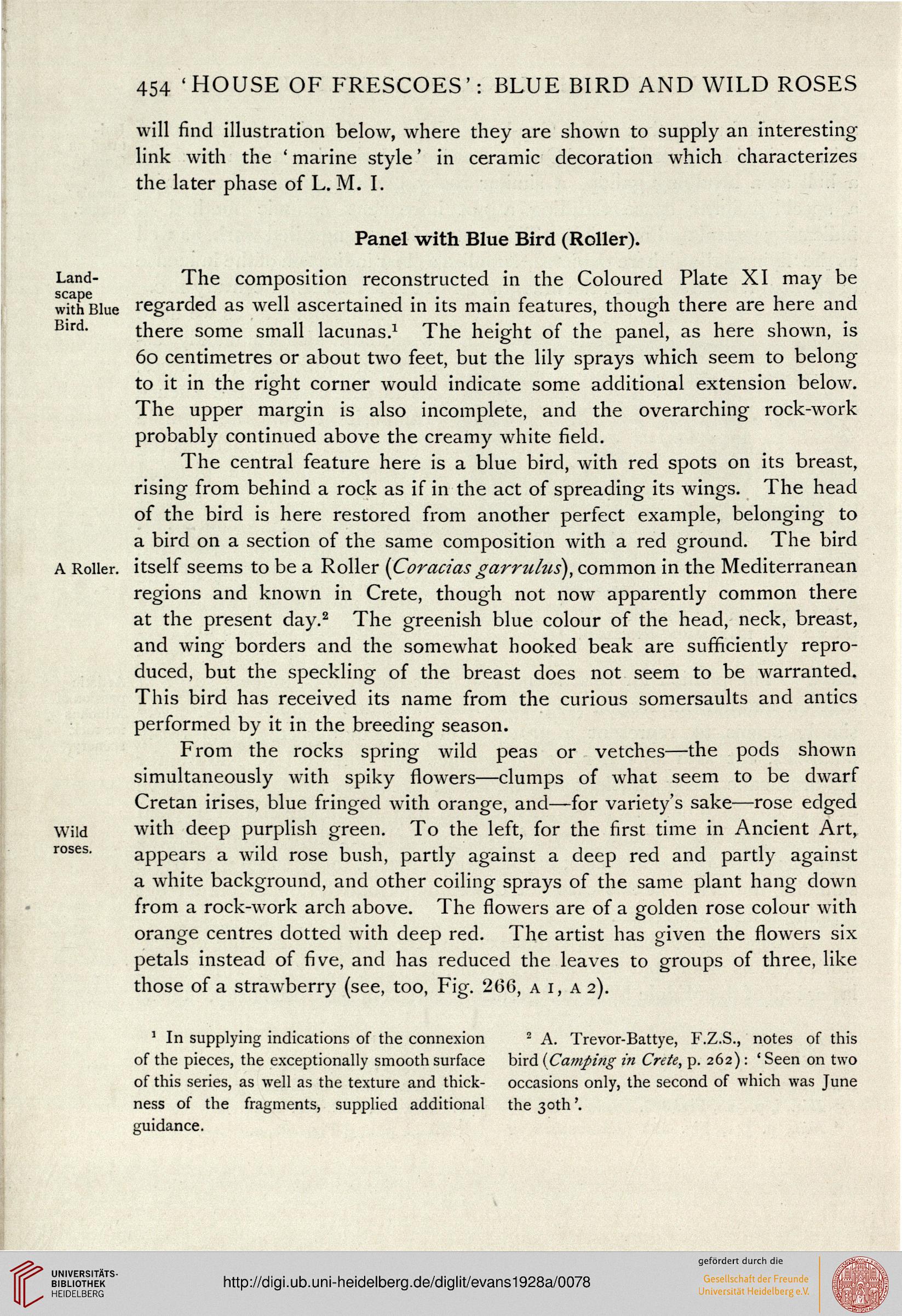454 'HOUSE OF FRESCOES': BLUE BIRD AND WILD ROSES
will find illustration below, where they are shown to supply an interesting-
link with the ' marine style' in ceramic decoration which characterizes
the later phase of L. M. I.
Panel with Blue Bird (Roller).
Land- The composition reconstructed in the Coloured Plate XI may be
withBlue regarded as well ascertained in its main features, though there are here and
Bird. there some small lacunas.1 The height of the panel, as here shown, is
60 centimetres or about two feet, but the lily sprays which seem to belong
to it in the right corner would indicate some additional extension below.
The upper margin is also incomplete, and the overarching rock-work
probably continued above the creamy white field.
The central feature here is a blue bird, with red spots on its breast,
rising from behind a rock as if in the act of spreading its wings. The head
of the bird is here restored from another perfect example, belonging to
a bird on a section of the same composition with a red ground. The bird
A Roller, itself seems to be a Roller (Coracias garrulus), common in the Mediterranean
regions and known in Crete, though not now apparently common there
at the present day.2 The greenish blue colour of the head, neck, breast,
and wing borders and the somewhat hooked beak are sufficiently repro-
duced, but the speckling of the breast does not seem to be warranted.
This bird has received its name from the curious somersaults and antics
performed by it in the breeding season.
From the rocks spring wild peas or vetches—the pods shown
simultaneously with spiky flowers—clumps of what seem to be dwarf
Cretan irises, blue fringed with orange, and—for variety's sake—rose edged
with deep purplish green. To the left, for the first time in Ancient Art,
appears a wild rose bush, partly against a deep red and partly against
a white background, and other coiling sprays of the same plant hang down
from a rock-work arch above. The flowers are of a golden rose colour with
orange centres dotted with deep red. The artist has given the flowers six
petals instead of five, and has reduced the leaves to groups of three, like
those of a strawberry (see, too, Fig. 266, a i, a 2).
Wild
roses
1 In supplying indications of the connexion
of the pieces, the exceptionally smooth surface
of this series, as well as the texture and thick-
ness of the fragments, supplied additional
guidance.
2 A. Trevor-Battye, F.Z.S., notes of this
bird (Camping in Crete, p. 262) : ' Seen on two
occasions only, the second of which was June
the 30th'.
will find illustration below, where they are shown to supply an interesting-
link with the ' marine style' in ceramic decoration which characterizes
the later phase of L. M. I.
Panel with Blue Bird (Roller).
Land- The composition reconstructed in the Coloured Plate XI may be
withBlue regarded as well ascertained in its main features, though there are here and
Bird. there some small lacunas.1 The height of the panel, as here shown, is
60 centimetres or about two feet, but the lily sprays which seem to belong
to it in the right corner would indicate some additional extension below.
The upper margin is also incomplete, and the overarching rock-work
probably continued above the creamy white field.
The central feature here is a blue bird, with red spots on its breast,
rising from behind a rock as if in the act of spreading its wings. The head
of the bird is here restored from another perfect example, belonging to
a bird on a section of the same composition with a red ground. The bird
A Roller, itself seems to be a Roller (Coracias garrulus), common in the Mediterranean
regions and known in Crete, though not now apparently common there
at the present day.2 The greenish blue colour of the head, neck, breast,
and wing borders and the somewhat hooked beak are sufficiently repro-
duced, but the speckling of the breast does not seem to be warranted.
This bird has received its name from the curious somersaults and antics
performed by it in the breeding season.
From the rocks spring wild peas or vetches—the pods shown
simultaneously with spiky flowers—clumps of what seem to be dwarf
Cretan irises, blue fringed with orange, and—for variety's sake—rose edged
with deep purplish green. To the left, for the first time in Ancient Art,
appears a wild rose bush, partly against a deep red and partly against
a white background, and other coiling sprays of the same plant hang down
from a rock-work arch above. The flowers are of a golden rose colour with
orange centres dotted with deep red. The artist has given the flowers six
petals instead of five, and has reduced the leaves to groups of three, like
those of a strawberry (see, too, Fig. 266, a i, a 2).
Wild
roses
1 In supplying indications of the connexion
of the pieces, the exceptionally smooth surface
of this series, as well as the texture and thick-
ness of the fragments, supplied additional
guidance.
2 A. Trevor-Battye, F.Z.S., notes of this
bird (Camping in Crete, p. 262) : ' Seen on two
occasions only, the second of which was June
the 30th'.




